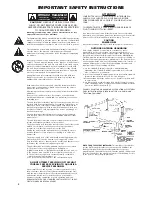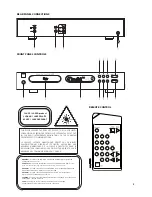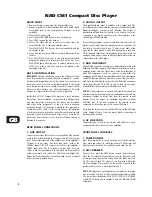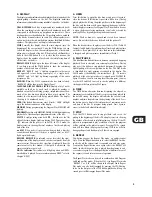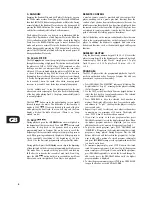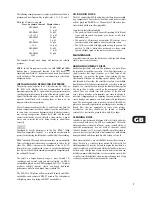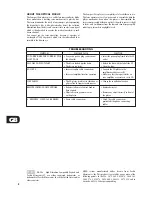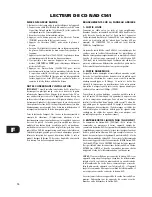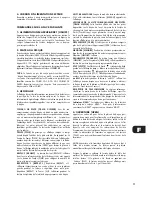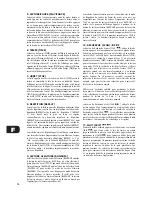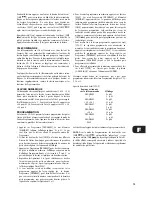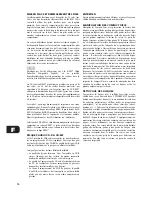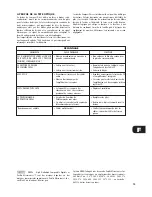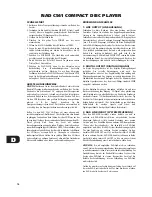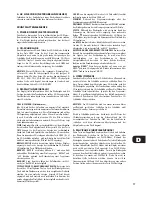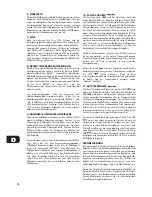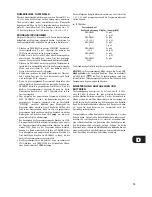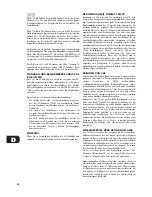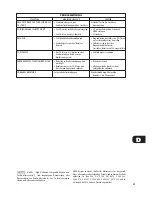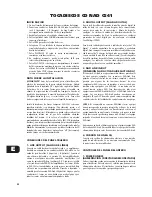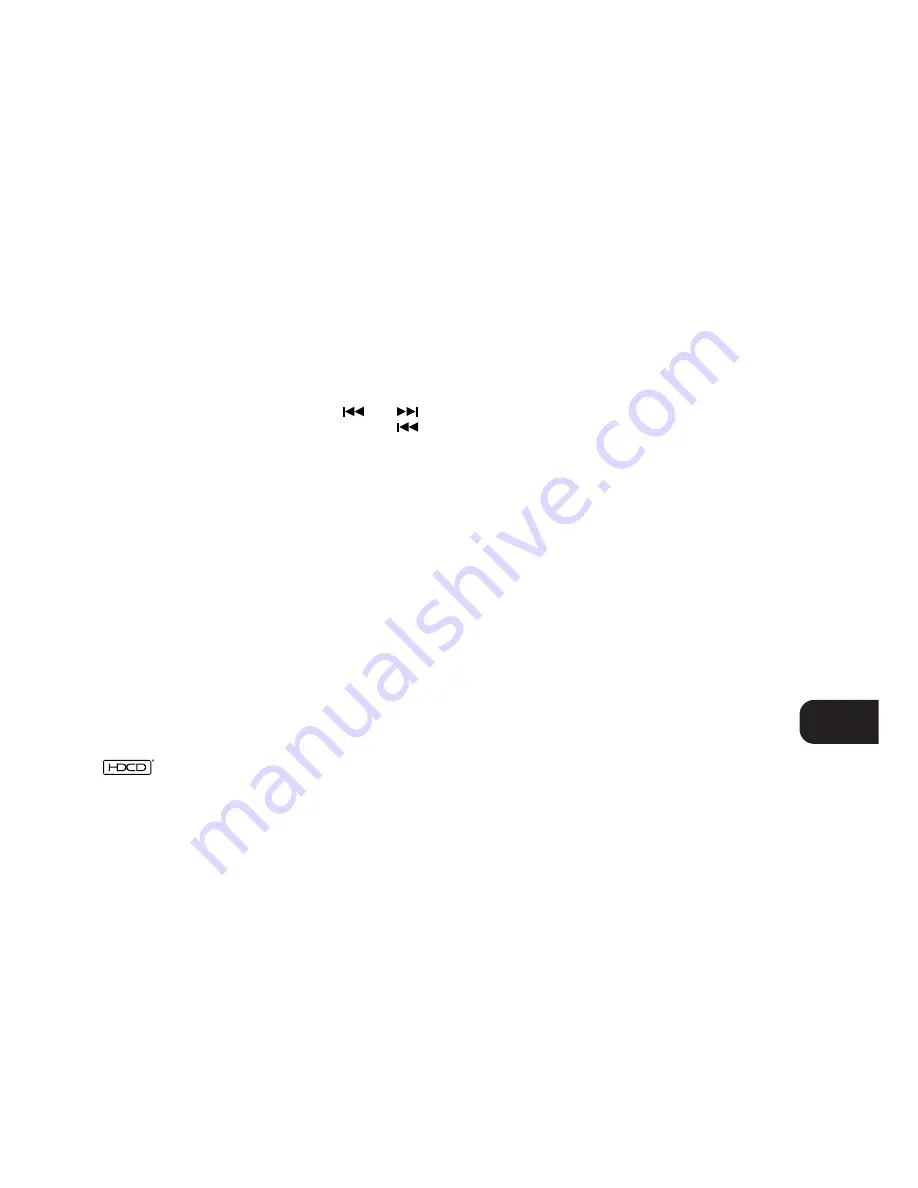
GB
7
The following example presents a step-by-step illustration of how to
program and start Program Play to play tracks 5, 23, 9, 16, and 1.
While the CD player is stopped:
Press on remote control
Display shows
PROGRAM
Pr p:01
5
5 p:01
PROGRAM
Pr p:02
+10, +10, 3
23 p:02
PROGRAM
Pr p:03
9
9 p:03
PROGRAM
Pr p:04
+10, 6
16 p:04
PROGRAM
Pr p:05
1
1 p:05
PROGRAM
Pr p:06
PLAY
The Calendar display track listing will indicate the selected
program.
NOTE:
In the Program-entry mode, the SKIP
and
buttons have a “wrap-around” function: if you SKIP Back
repeatedly from Track 01, the number counts down from the final
track on the disc. This provides a convenient way to select high-
numbered tracks.
INSTALLING AND REPLACING BATTERIES
The remote control requires two 1.5-volt AAA-size (i.e. UM-4 or
IEC RO3) cells. Alkaline cells are recommended, to obtain
maximum operating life. To open the battery compartment, place
your fingertip in the recess on the rear of the remote control, push
against the flexible edge of the battery cover and lift the cover
upwards. Install fresh cells, orienting them as shown on the
diagram within the compartment.
The coil springs should contact the (-) end of each cell. Push the
battery compartment cover back and press gently until it latches.
In some cases, corrosion or fingerprint oil on the battery contacts
may cause poor operation. Remove both cells, rub the metal
contacts at both ends of each cell with a clean cloth or a pencil
eraser, and re-install the cells, being careful to orient them
correctly.
Developed by Pacific Microsonics in the USA, HDCD
®
(High
Definition Compatible Digital
®
) is a patented encode/decode
process for delivering the full richness and detail of the recording.
HDCD
®
encoded CDs sound better because they are encoded with
20-bits of real musical information, as compared to 16-bits for all
other CDs. HDCD
®
overcomes the limitation of the 16-bit CD
format by using a sophisticated system to encode the additional
four bits onto the CD while remaining completely compatible with
the existing CD format.
The result is a larger dynamic range, a more focused 3-D
soundstage, and natural vocal and musical timbre. An HDCD-
encoded disc played on the HDCD-equipped NAD C541 CD player
produces audibly superior clarity and depth. Enhanced
performance will also be obtained from standard CDs.
The NAD C541 CD player will automatically identify an HDCD
®
encoded disc and activate its HDCD
®
decoder. The red indicator
will light up when it’s playing an HDCD
®
encoded disc.
CD-R AUDIO DISCS
The C541 can play back CD-R audio discs that have been recorded
on a computer or CD-recorder. It should be noted however that it
will not play back CD-RW discs. The quality of CD-R audio discs
varies widely which may affect playability.
Some factors that affect playability:
• The quality of the disc itself. Generally speaking, CD-R blanks
from well-renowned companies give better results than
unbranded ones.
• The quality of CD-recorder or computer CD re/writer. Some
recorders and writers produce better results than others.
• The CD-R was created with high-speed writing. In general, the
quality of a CD-R is better when produced at a lower speed
against a higher speed on the same recorder or re/writer.
MAINTENANCE
At periodic intervals, open the disc drawer and wipe with a damp
cloth to remove any loose dust.
HANDLING COMPACT DISCS
Handle Compact Discs with care. The playback of a disc will not
be impaired by small dust particles, a few light fingerprints, or
slight scratches. But large scratches, or a thick layer of oily
fingerprints, can pre-vent the player from tracking the disc.
(Incidentally, although the tracking optical pickup “plays” the
disc through its clear side, the actual data surface is embedded
directly beneath the label, protected only by a very thin coating of
lacquer. So a scratch that cuts through the label may damage the
disc more than a similar scratch on the transparent “playing”
surface. Thus you should treat both surfaces of the disc with
care.) Severe scratches or fingerprints may cause the player to
mis-track (skipping ahead, or repeating the same passage). Less
severe damage may produce very brief bursts of high-frequency
noise. The tracking and error-correction circuits of this NAD CD
player are unusually sophisticated, providing secure tracking of
flawed discs that are unplayable on some other players.
Nevertheless, the discs should not be abused or handled
carelessly. For best results, grasp the disc only by its edges.
CLEANING DISCS
Soiled discs may be cleaned by wiping with a soft cloth, either dry
or moistened, with water. Do NOT use conventional LP record-
cleaning products (cleaning solutions, sprays, treated cloths, or
anti-static preparations), nor any kind of chemical solvent
(alcohol, benzene, et al). A severely soiled disc may be washed in
a warm-water spray, possibly with a small amount of a mild kitchen
detergent added, and then wiped dry with a clean, soft towel.
When cleaning the disc, use only RADIAL strokes (from centre to
edge). Never use a circular wiping motion like that used for
cleaning ordinary LP records, because in wiping the disc there is a
risk of scratching it. A radial scratch will do the least harm because
it affects only a small portion of each circular data track, which can
be fully compensated by the player’ s error-correction circuits. But
a circular scratch that follows a data track may damage such a long
continuous segment of data that it cannot be corrected.
Summary of Contents for C541
Page 9: ...GB 9...
Page 45: ...S 45...


